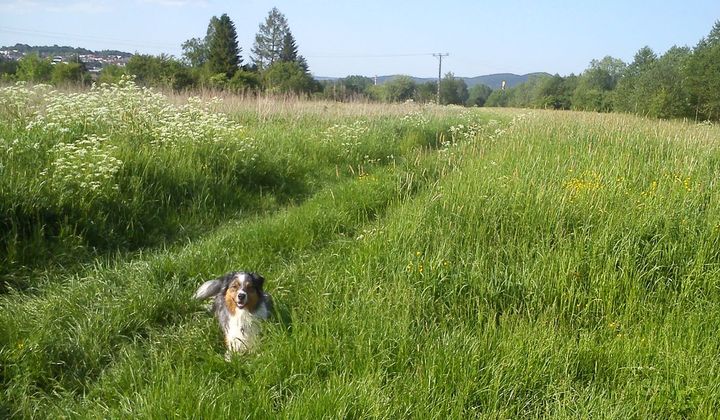Fetching wolves, canine behavior documented
13 wolf pups were researched by putting them through standard behavioral tests usually used by dog breeders to assess predispositions of working dogs. 3 of 13 tested wolf cubs spontaneously showed interest to the ball being thrown - 2 of them fetched it twice, 3rd one did it every time.
"Fetch it!" - or even more official "Fetch!" if used in dog obedience training (fetching on command) - is a verbal signal causing a positively reinforced dog to retrieve an indicated item directly to the handler (ultimately to the handler's hands).
Retrieval itself stands for a grabbed 'prey' being dropped intentionally nearby (at the human’s feet, handing it to a human, etc.) by a dog which returned with it to the handler. To fetch means to trigger a specific behavior chain (partial predatory sequenced) associated with a toy tendency (play behavior preference, prey drive correlated) as a part of dog-human relations (social behavior element, an indicator of how much a dog is predisposed to cooperate with a human).
Some young dogs have a natural fetch - they play fetch as puppies and retrieve a fetched toy to a human instinctively. Anyway, dog cubs do not come into the world naturally born tame, but just evolutionary open to the domestication process. They habituate to human presence during a very short developmental stage related to the optimal socialization window - the most sensitive part of the dog offspring management. Likewise, properly handled captive born wolf cubs (less tamable than dog puppies, with way much shorter socialization related part) are temporarily taken away from their wolf parents (extremely early) and hand-reared by professional caretakers (feeding them every 3 hours, sleeping together) to habituate to human presence by imprinting (assuming not all senses activated yet) optionally even before their socialization window is open.
Christina Hansen Wheat researched 13 wolf pups of 3 litters in the lab placed 100 km away from the patronage institution, putting them being 7-9 weeks old through standard behavioral tests usually used by dog breeders to assess predispositions of working dogs (then matching every puppy to an appropriate owner). A stranger - who every tested animal was left with in a barren room - was supposed to throw a tennis ball and urge each wolf pup separately to bring it back.
Let's consider the video material in the context of genus Canis predatory sequence and complex social behavior focused on human:
- Prey drive is triggered by moving/flying object thrown by a handler like it happens in nature - the ball is chased then grabbed in regular way preceding the 'killing' link.
- The "killed prey" is taken away to 'dissect' - redirected into independent play behavior elements (putting the toy into motion, dummy chasing simulation).
- The handler is trying to redirect the cub's attention like it proceeds in dog frisbee where a trained dog is encouraged to retrieve a flying disc after catching it (which closes canine predatory sequence when the 'grabbing' link is reached).
- Tested wolf pup is fetching the ball, seemingly intending to retrieve it to the handler.
The test results does scientifically matter - 3 of 13 tested wolf cubs spontaneously passed showing interest / not ignoring the ball being thrown (all of the same litter); 2 of them (Lemmy and Elvis) returned it twice, 3rd one (Sting) did it every time (3 trials scheduled).
Our results suggest that, although probably rare, standing variation in the
expression of human-directed behavior, including play, in ancestral populations could have been an important target for early selective pressures exerted during dog domestication.
— researchers report.
Both genus Canis species have a common wolf ancestor from which they split up around 15,000 years ago, into two (sub)species.
- Pre-dogs abandoned wildlife for being a companion animal - cooperative, human focused, depending on human as a resources management (preliminarily adapted to scavenge).
- Wolves remained wild predators, strictly carnivore social animals living/hunting in packs deep in forests, avoiding humans as much as possible.
There's a possibility that modern wolf populations diverged from the primal one which put pre-dogs into domestication process previously. Extensively hunted in the past, their descendants might be more vigilant and avoidant of human presence by adaptation to survive in offered ecological niches.
For 3 years, Christina Hansen Wheat has collected data coming from hand-reared wolves and dogs raised in comparable conditions to study differences (and similarities) between dogs and modern wolves. Researched litter representatives - as professionally raised young adult wolf siblings - in age of 7-10 months were adopted out to familiar European animal parks, where they are still visited by Christina (one of their former caretakers) always in company of same friendly emotions.
references:
Intrinsic Ball Retrieving in Wolf Puppies Suggests Standing Ancestral Variation for Human-Directed Play Behavior (2020); research by Christina Hansen Wheat, Hans Termin (Stockholm University).

